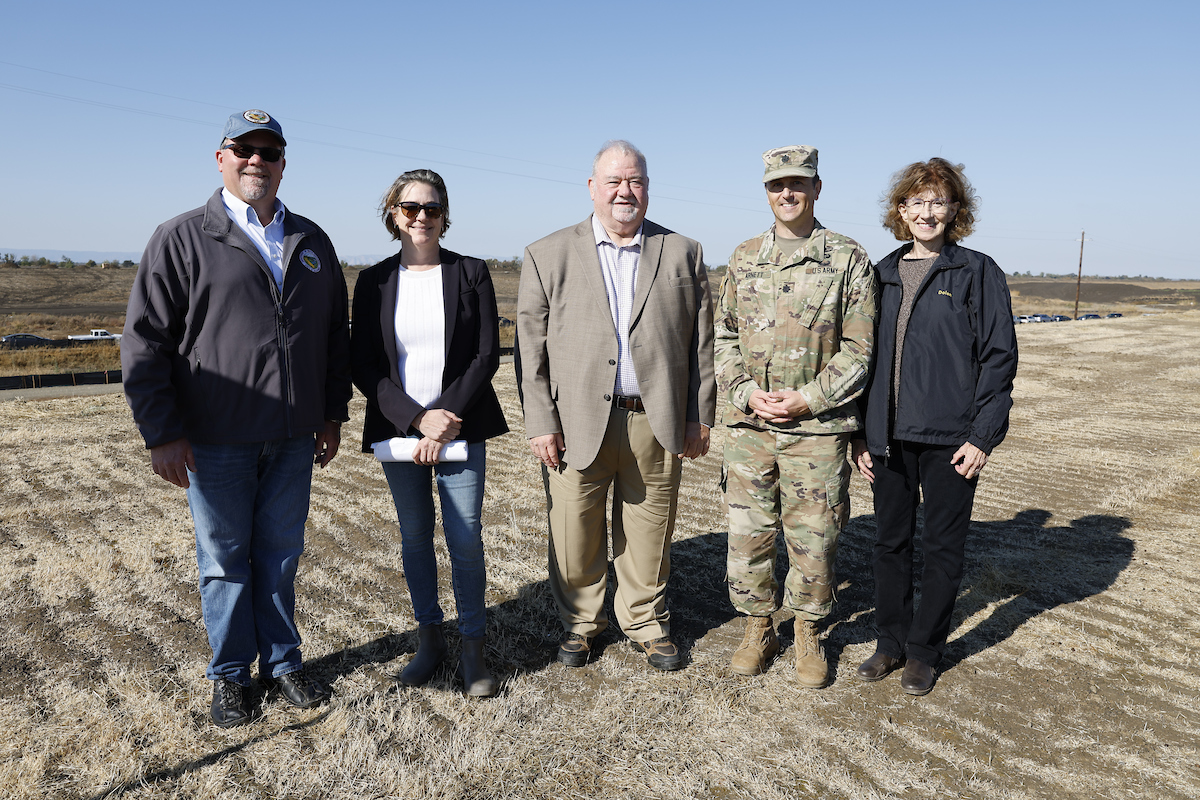DWR Deputy Director of Flood Management and Dam Safety Gary Lipner, DWR Director Karla Nemeth, Sacramento Area Flood Control Agency Executive Director Rick Johnson, United States Army Corps of Engineers Lieutenant Colonel and Acting Sacramento District Commander Kevin Arnett, and Central Valley Flood Protection Board President Jane Dolan
Extreme weather events in California in 2023 highlight the need for more awareness of flood risks in California and now is the time for all Californians to prepare for possible flooding. That was the message from state and federal agencies gathered today to show how they are joining forces to protect communities from another potential wet winter.
This week marks the start of Flood Preparedness Week, which runs from October 21 to October 28, and the California Department of Water Resources (DWR), the California Natural Resources Agency (CNRA), the U.S. Army Corps of Engineers, and the Central Valley Flood Protection Board gathered at the Lower Elkhorn Basin Levee Setback Project in Sacramento to remind Californians of their flood risk. The project is an example of the work being done by state, federal and local partners to expand flood plains to protect communities from flooding.
The Lower Elkhorn Basin Levee Setback Project is a $280 million project that when combined with the U.S. Army Corps of Engineers’ Sacramento Weir Widening Project will allow increased flow from the Sacramento River into the Yolo Bypass during high flow events, reducing flood risk for 780,000 people.
“Climate extremes are creating more challenges for California, including increasing flood risk across the state,” said DWR Director Karla Nemeth. “Extreme drought and extreme flooding are both expected in the future, and California is responding with historic investments in projects that work with nature and collaborate with our Tribal, state, federal, and local partners to implement real solutions that protect communities.”
More than seven million California residents are at risk of flooding, and many don’t realize it. Flooding can occur throughout the state, from rural to urban areas, in valley and desert communities, in mountain regions, and along the coast. Every California county has received a flood-related emergency declaration in the past 20 years. Flooding can also happen at any time of year and can even occur during drought years.
Communities that are downslope of recent wildfires are also especially prone to flash floods and debris slides, and landscapes impacted by wildfires can take up to five years to recover. To prepare for flooding, all Californians should follow three basic steps:
- Be aware of your risk – know whether your home is downslope of a burn area or in a floodplain; pay attention to weather forecasts; listen to local authorities.
- Be prepared – always have an emergency evacuation kit ready; be prepared to evacuate early; have a plan for where you will go in an emergency and what to do with your pets.
- Take action – subscribe to your local emergency providers to get updated information. Visit the National Weather Service webpage to get updated weather information for your community. If local authorities issue an evacuation order, do not delay, follow local guidelines for evacuation and never attempt to drive through a flooded roadway.
To prepare for another potentially wet water year, DWR is working with Tribal, federal, state, and local partners to protect communities and lives. The State-Federal Flood Operations Center has pre-positioned flood fight materials at more locations across the state and is beginning this water year with more supplies on hand, including 2.4 million more sandbags. DWR is also working with local partners to provide flood fight training to vulnerable communities and coordinating pre-season emergency response meetings with county offices of emergency services across the state.
DWR and its partners will be sharing important flood preparedness messages throughout the week on social media and through community events across the state. Last week, DWR joined with River Partners and American Rivers to celebrate the Turning Point Basin floodplain restoration project, which will expand floodways to protect rural disadvantaged communities and provide critical habitat and environmental benefits. The Governor, in partnership with the Legislature, has invested more than $430 million in the most recent budget to support similar projects across the state and increase flood response to protect communities from future flooding.
For more information on finding your flood risk visit https://myhazards.caloes.ca.gov/
For information on obtaining flood insurance visit https://www.floodsmart.gov/
For information on how you can prepare your household for flood emergencies, visit https://www.ready.gov/kit
For Pixel link images from today’s event visit https://pixel-ca-dwr.photoshelter.com/search?terms=P2725&
For B-roll and soundbites from today’s event and previous construction work, click here.
Contact:
Jason Ince, Information Officer, Public Affairs, Department of Water Resources
(916) 820-8138 | media@water.ca.gov
